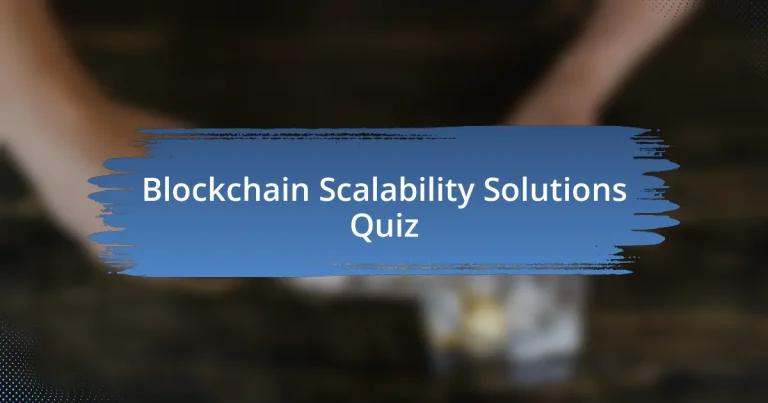
Start of Blockchain Scalability Solutions Quiz
1. What is the primary challenge in blockchain scalability?
- Slow consensus mechanism and low security.
- Limited throughput and high transaction fees.
- Complex smart contract implementation and user interface.
- High energy consumption and centralized node control.
2. What are the four main categories of blockchain scalability solutions?
- Blockchain forks, Peer-to-peer networks, Multi-signature wallets.
- Cryptographic hashing, Decentralized applications, Token standards.
- Distributed ledger techniques, Hash functions, Smart contracts.
- Layer 1 (On-chain) solutions, Layer 2 (Off-chain) solutions, Scalable consensus methods, and hybrid solutions.
3. What is Segregated Witness (SegWit)?
- A feature that creates more complex smart contracts on the network.
- A protocol upgrade that separates transaction signature data from transaction data to enhance transaction throughput.
- A method that increases block size limits to allow more transactions.
- A consensus algorithm that improves security on the blockchain.
4. How does Segregated Witness (SegWit) improve scalability?
- By making blocks smaller, freeing up space for additional transactions, and improving transaction efficiency.
- By introducing a new consensus mechanism that processes transactions faster.
- By reducing the overall number of nodes in the network.
- By increasing block size limits to allow more transactions per block.
5. What is sharding in blockchain technology?
- A strategy to increase the size of each block to accommodate more transactions.
- A technique that divides the blockchain network into smaller, more manageable data sets called shards to enhance scalability.
- A process that encrypts all data on the blockchain to improve security.
- A method for storing transactions in a single large database without fragmentation.
6. How does sharding improve transaction throughput?
- By limiting the number of transactions entered into the system, thus reducing congestion.
- By merging all transactions into a single batch to streamline processing.
- By requiring all nodes to validate every transaction, ensuring thoroughness.
- By allowing nodes to process transactions in parallel across different shards, increasing overall processing capacity.
7. What are the challenges associated with sharding?
- Simplifying smart contract development and deployment.
- Lowering the cost of transaction fees across the network.
- Enhancing user interface design for better accessibility.
- Ensuring shard security, maintaining tamper-proof transaction validation, and implementing cross-shard communication mechanisms.
8. What is the role of sharding in Ethereum`s scaling strategy?
- It serves solely to enhance security by ensuring decentralization across nodes.
- It primarily aims to reduce transaction fees by limiting the number of participants.
- Its main function is to increase the block size to accommodate more transactions.
- Initially planned to improve data availability but now focused on supporting Layer 2 networks by verifying data availability from shards.
9. What is Layer 2 in blockchain technology?
- A protocol that adds more verification steps to transactions.
- A type of cryptocurrency that functions on its own blockchain.
- A network that processes large batches of transactions and sends them to the base layer for validation.
- A system that operates independently without any external validation.
10. What are the challenges of Layer 2 networks?
- High energy consumption and slow processing times.
- Incompatibility with existing Layer 1 solutions.
- Issues related to decentralization and data availability.
- Limited privacy and high maintenance costs.
11. What is the proposed solution by Vitalik Buterin for data availability in Ethereum?
- A combination of a randomly selected committee and random sampling to verify data availability from Layer 2 networks.
- Relying solely on off-chain storage solutions for transaction data.
- A fixed committee structure verifying all transactions in real-time.
- Utilizing a single large node to handle all data requests.
12. What is the Scalability Trilemma in blockchain technology?
- The trade-off between scalability, security, and decentralization.
- The relationship between nodes, miners, and validators.
- The balance between speed, cost, and simplicity.
- The equation involving privacy, transparency, and speed.
13. What is the primary advantage of sharding in blockchain?
- Simplified user interface for blockchain applications.
- Enhanced network scalability and performance by distributing data across multiple shards.
- Increased reliance on centralized servers for data management.
- Reduced transaction fees and faster confirmation times.
14. How does sharding reduce the load on nodes?
- By requiring all nodes to process every transaction in the network.
- By consolidating all transactions into one massive block for easier handling.
- By limiting transactions to a single node, thereby increasing its workload.
- By allowing nodes to process only the transactions that pertain to their specific shard.
15. What is the energy efficiency benefit of sharding?
- Slower transaction speeds leading to wasted energy.
- Reduced resource requirements for processing transactions, leading to more energy-efficient operations.
- Increased transaction size resulting in higher energy consumption.
- More complex algorithms requiring additional processing power.
16. What is the significance of sharding in maintaining security?
- It centralizes data processing to enhance speed and efficiency.
- It simplifies transaction verification by combining multiple datasets into one.
- It maintains the security and decentralization aspects of blockchain networks by distributing data across multiple shards.
- It increases the block size to accommodate more transactions in a single block.
17. How does sharding increase transaction speed?
- By merging all transactions into a single block for increased efficiency.
- By requiring every node to process every transaction sequentially.
- By slowing down the transaction validation process to ensure accuracy.
- By processing transactions in parallel across different shards, significantly reducing wait times for users.
18. What is the impact of sharding on network capacity?
- It improves network capacity by centralizing all data processing in one location.
- It decreases the network capacity by limiting the number of nodes in the system.
- It enhances network capacity by requiring less participation from nodes in transaction processing.
- It scales the network capacity as more nodes join the system by distributing the data load across multiple shards.
19. What are the popular Layer 1 scalability solutions?
- Hard forking
- Segregated Witness
- Staking
- Sharding
20. What is the role of hard forking in blockchain scalability?
- It involves making significant changes to the blockchain protocol to enhance scalability, such as increasing block size limits or reducing block verification time.
- It creates independent blockchains that do not interact with each other or the main chain.
- It eliminates the need for consensus mechanisms by streamlining transaction processing.
- It decreases the number of transactions processed by enforcing stricter validation rules.
21. How does sharding mitigate congestion in blockchain networks?
- By condensing all transactions into a single processing node for faster execution.
- By increasing the block size and reducing verification time for transactions.
- By forcing all nodes to process every transaction sequentially to ensure security.
- By distributing the data load across multiple shards, each handling a fraction of the total network load.
22. What is the benefit of sharding in reducing latency?
- By increasing the block size limit, which speeds up all transactions in the network.
- By allowing each node to process only the transactions that pertain to their specific shard, reducing the overall latency in transaction processing.
- By requiring nodes to verify transactions from all shards to enhance network trust.
- By grouping all transactions into a single shard for faster validation and consensus.
23. What is the relationship between sharding and node operation?
- Sharding makes node operation more manageable by reducing the burden on individual nodes.
- Sharding makes node operation irrelevant, as nodes stop processing transactions.
- Sharding eliminates the need for nodes to validate transactions entirely.
- Sharding complicates node operation by increasing individual storage needs.
24. How does sharding improve user experience in blockchain networks?
- By limiting the number of transactions that can be processed simultaneously to ensure accuracy.
- By centralizing the data processing to improve speed and efficiency.
- By requiring all nodes to validate every transaction before approval.
- By significantly reducing wait times for users through parallel transaction processing across different shards.
25. What is the environmental benefit of sharding?
- It leads to more energy-efficient operations by requiring fewer resources to process transactions.
- It reduces transaction verification times but increases energy use.
- It increases the carbon footprint due to additional computing needs.
- It has no impact on energy consumption in blockchains.
26. What is the significance of sharding in accommodating network growth?
- It centralizes control of the network to a few key shards, limiting accessibility.
- It allows for the creation of additional shards as the network grows, maintaining high throughput and responsiveness.
- It reduces the number of transactions processed simultaneously, causing bottlenecks.
- It prevents the addition of new nodes, slowing down the network performance.
27. How does sharding enhance parallel processing in blockchain networks?
- By creating a single, larger block that holds more transactions at once.
- By dividing the network into shards, each processing its own set of transactions in parallel.
- By ensuring that all nodes work on every transaction sequentially, reducing errors.
- By using a centralized server to handle all transactions efficiently.
28. What are the key challenges in implementing sharding?
- Reducing block size to enhance individual transaction speed.
- Simplifying consensus algorithms to decrease validation time.
- Ensuring shard security, maintaining tamper-proof transaction validation, and implementing cross-shard communication mechanisms.
- Increasing the number of nodes to improve network security.
29. What is the primary goal of sharding in Ethereum’s scaling strategy?
- To centralize control of the network to improve efficiency.
- To store all transactions in a single database for easy access.
- To support Layer 2 networks by verifying data availability from shards.
- To increase the size of individual blocks for more data.
30. How does sharding address the issue of data availability in blockchain networks?
- By requiring all nodes to process every transaction in the network.
- By eliminating the need for consensus mechanisms entirely in the network.
- By consolidating all transactions into a single shard for faster processing.
- By verifying the availability of data deposited from Layer 2 networks using a combination of a randomly selected committee and random sampling.

Quiz Successfully Completed!
Congratulations on completing the quiz on Blockchain Scalability Solutions! You’ve now gained insights into important aspects of blockchain technology. Understanding scalability issues is crucial, as they directly impact network efficiency and usability. This quiz has likely helped you grasp various solutions that address the challenges of scalability, such as sharding, layer 2 solutions, and more.
As you engaged with the questions, you might have uncovered the importance of these solutions in enhancing transaction speeds and reducing costs. Learning about different approaches equips you to appreciate the innovations taking place in the blockchain space. You’ve taken an important step in expanding your knowledge and staying updated on this rapidly evolving topic.
If you’re eager to delve deeper, we invite you to explore the next section on this page. It contains comprehensive information on Blockchain Scalability Solutions that can further enhance your understanding. Whether you’re a beginner or seeking advanced insights, you’ll find valuable resources to expand your knowledge in this exciting field.

Blockchain Scalability Solutions
Understanding Blockchain Scalability
Blockchain scalability refers to the ability of a blockchain network to handle a growing amount of transactions. It involves enhancing the network’s capacity while maintaining security and decentralization. As the number of users and transactions increases, blockchains can face delays and higher fees, disrupting their effectiveness. Solutions aim to improve throughput, reducing congestion and facilitating faster transaction confirmations.
Types of Scalability Solutions
Scalability solutions can be categorized into two primary types: on-chain and off-chain. On-chain solutions involve altering the blockchain protocol to increase capacity, such as changing block sizes or consensus mechanisms. Off-chain solutions allow transactions to occur outside of the main chain, which are later settled back onto the blockchain, thus reducing the load. Both approaches aim to enhance efficiency and user experience.
Layer 2 Solutions
Layer 2 solutions operate on top of existing blockchains to improve scalability without modifying the underlying blockchain protocol. Examples include the Lightning Network for Bitcoin and Plasma for Ethereum. These solutions enable faster transactions by conducting them off the main chain while ensuring security through the primary blockchain’s consensus. Layer 2 techniques are gaining traction for their ability to significantly reduce fees and increase transaction speeds.
Sharding as a Scalability Technique
Sharding is a technique that splits a blockchain network into smaller, more manageable pieces called shards. Each shard processes its own transactions and smart contracts independently, allowing for parallel processing. This increases overall network throughput and efficiency. Ethereum 2.0 is implementing sharding to address scalability concerns, aiming to enhance its transaction capacity massively.
Future Prospects of Blockchain Scalability Solutions
The future of blockchain scalability solutions includes advancements in technologies such as zero-knowledge proofs and adaptive block sizes. These innovations promise to enhance transaction verification speed and improve privacy. Research and development continue to focus on combining various scalability methods, ensuring that blockchains can support mass adoption without sacrificing security or decentralization.
What are Blockchain Scalability Solutions?
Blockchain scalability solutions are methodologies and technologies designed to enhance the transaction throughput and overall efficiency of blockchain networks. They aim to address the limitations in speed and capacity that can hinder blockchain performance. These solutions include layer-2 protocols, such as the Lightning Network for Bitcoin, and sharding techniques used in Ethereum 2.0. For instance, the Lightning Network increases transaction speeds by enabling off-chain transactions. According to various studies, these solutions can potentially increase transaction capacity to thousands per second, significantly surpassing the base layer performance.
How do Blockchain Scalability Solutions work?
Blockchain scalability solutions work by optimizing the way transactions are processed and stored. They often utilize techniques such as off-chain processing, partitioning data, and increasing block size. For example, in off-chain solutions, transactions occur outside the main blockchain and are later settled on-chain, reducing congestion. Sharding divides the blockchain into smaller, manageable pieces that can process transactions concurrently, improving speed. Research indicates that sharding can potentially allow networks to handle over 100,000 transactions per second when fully implemented.
Where are Blockchain Scalability Solutions applied?
Blockchain scalability solutions are applied across various blockchain platforms and projects. They are commonly used in cryptocurrencies like Bitcoin and Ethereum aimed at enhancing their transaction capacity. Additionally, enterprise solutions, such as those utilized by IBM’s Hyperledger Fabric, employ scalability techniques to facilitate faster and more efficient transactions in business applications. Major platforms like Binance Smart Chain also integrate scaling solutions to handle decentralized finance (DeFi) operations effectively.
When are Blockchain Scalability Solutions needed?
Blockchain scalability solutions are needed when a blockchain network experiences limited transaction throughput, resulting in delays and increased fees. This typically occurs during periods of high demand, such as market volatility or popular events in decentralized applications (dApps). For example, Ethereum’s network congestion during the DeFi boom in 2020 highlighted the urgent requirement for scalability solutions. In such cases, implementing these solutions is crucial to maintain usability and user satisfaction.
Who develops Blockchain Scalability Solutions?
Blockchain scalability solutions are developed by a combination of independent entities, research organizations, and large technology companies. Open-source communities like Ethereum’s developers and Bitcoin Core contribute significantly to the evolution of these solutions. Additionally, companies such as ConsenSys and Blockstream are actively involved in creating frameworks and tools that enhance scalability. Collaborative efforts within the blockchain community drive innovation and implementation of these solutions, often backed by extensive research and testing.


